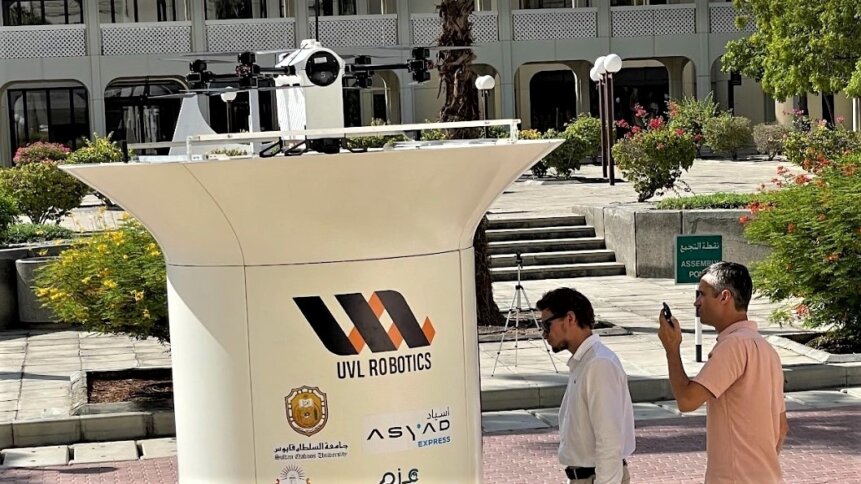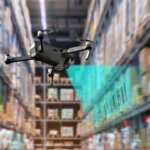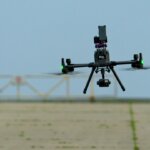Drone delivery costs on par with couriers

|
Getting your Trinity Audio player ready...
|
Practically, using drones to deliver packages makes sense. The opportunities for automation are huge. Drones don’t get stuck in city traffic. Uncrewed aerial vehicles (UAVs) can operate in areas with poor road infrastructure. In fact, drones can deliver packages to regions that are unreachable by regular couriers. But, if you look outside today, it’s unlikely that you’ll see many drones flying around making deliveries. Unless you live in the Middle East. UVL Robotics – which is headquartered in California, US, and has its R&D facilities in Oman – is showing that drone delivery costs can be on par with couriers.
The story behind UVL’s rollout of commercial drone delivery operations in Oman begins not outside (as you may expect), but inside – with warehouse inventory management. Around eight years ago, Eugene Grankin – UVL’s co-founder and CEO – was working in the global supply chain sector and wanted to use drone technology to speed up stock counts. However, at the time, available solutions were lacking, which led him to eventually team up with logistics expert, Moosa Al Balushi (UVL Robotics’ other co-founder) to build their own solution.
Typically, stock inside a warehouse will be checked a couple of times a year to make sure that everything is where it’s supposed to be and in good condition. Done manually, it can take operators three days to count 10,000 pallets. By using drones to perform inventory counts, that time – according to Grankin – can be cut to just an hour. And, as well as the speed boost, there are advantages in terms of both safety (warehouse operatives don’t have to climb ladders or use scissor lifts) and accuracy (computerized systems generate better data).
Today, UVL Robotics offers its drone-based warehouse inventory service to Fortune 500 large-enterprises, who – once they’ve tried it – never go back to manual counts again. The advantages for customers are clear. Today, aerial robotics is transforming warehouse inventory monitoring. For drone systems developers such as Grankin and his team, the application was helpful in maturing the technology as – unlike using drones in the open air – you don’t need any permission to fly indoors.
Now, drone operators are applying those skills elsewhere, across various verticals, such as food delivery – one of the most popular applications with customers – and the transport of medicines. “We’re already on the ground providing services,” Grankin told TechHQ. “And we’re proud to say that it’s at a commercial stage.”
Safety first
Getting to this point required, among other things, showing authorities such as Oman’s Ministry of Transport that drone delivery is safe. Oman is a smaller country where things can move quickly – something that plays to its strategy of being fast to implement new technologies. But no project gets the go-ahead without fulfilling safety criteria. The delivery drones include a number of built-in safety features, such as multiple rotors – units are able to fly even if up to two out of the aircraft’s motors were to fail. Drones are fitted with LiDAR to enable accurate range finding, as well as GPS transceivers.
Human operators can take over the controls in the event of a failure in autonomous flight. And, as a worst-case scenario, the delivery drones are equipped with a parachute to ensure a soft landing. The solution integrates with unmanned traffic management (UTM) systems, which are used to monitor the whereabouts of drones in designated airspace. During flight, delivery drones send telemetry – which includes speed and location data – in real time to satisfy regulatory requirements. Telemetry information can also be used for predictive maintenance, giving advance warning of any servicing that needs to be carried out. For example, if parameters start to move away from their normal values.
UVL Robotics has received the first Beyond Visual Line of Sight (BVLOS) permission in the region for drone delivery from the Sultanate’s Civil Aviation Authority. And this allows the company to carry out day-to-day operations. BVLOS activity is highly regulated by aviation authorities around the world, so the achievement is recognition that drone delivery solutions have met a high bar in flight safety. But what about the rest of story, including optimizing drone delivery costs?
Keeping drone delivery costs low
Ticking the safety box is just one part of the puzzle. As Grankin points out, there’s a whole lot of other infrastructure to consider to make drone delivery a reality. In Oman, this includes a network of so-called smart parcel stations. Slightly bigger than a telephone box, the structures provide a safe landing pad for the rotor-powered aircraft. Smart parcel stations include other features too, such as the ability to automatically exchange the drone’s battery for a fresh one, retrieve the payload, and move parcels to empty storage bays.
Customers can use the stations to not just pick up, but also deposit parcels, which is important to enable processes such as reverse supply chain. In other words, the capability of users to reject deliveries or return goods. Zero-emission electric drones are well-suited to transporting payloads up to around 5kg, which represents a large share of courier deliveries. In fact, most individual items may be well below this – 85% of Amazon’s deliveries reportedly weigh less than 5 pounds (2.3 kg). And this signposts an opportunity to further reduce drone delivery costs. Currently, one drone (which is capable of servicing as many as 60 orders per day) carries a single order in its container, which can be a strong cardboard box or specially-designed holder for food or medicines.
Combining multiple orders into individual trips – a feature that’s scheduled for development – is expected to further improve pricing. The cost reduction could even mean that drone delivery becomes the cheapest way of transporting goods from A to B, at least for relatively lightweight items that have to be shipped a few kilometres.
In 2023, Grankin and the UVL Robotics team will be bringing their drone delivery solution to other sites in the Middle East. The United Arab Emirates and Saudi Arabia will be next. And Kuwait and Egypt have also expressed an interest in the technology.
The strong momentum behind drone transportation is such that industry bodies such as the Drone Delivery Group (the UK’s largest group of drone industry experts) is urging the UK government to press ahead with regulation to avoid falling behind. India has announced its intention to become a global drone hub by 2030, and – as this article has described – the Middle East already has commercial drone delivery solutions up and running.










